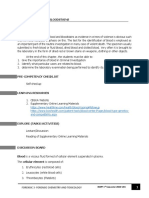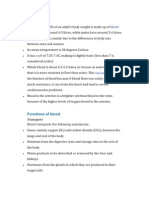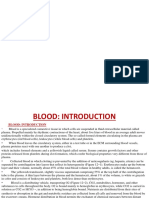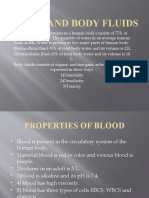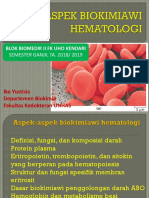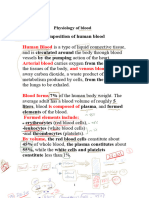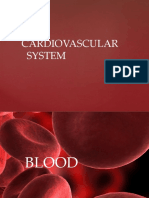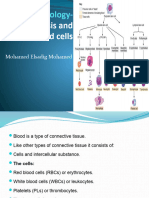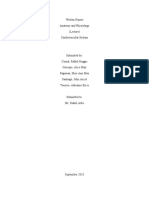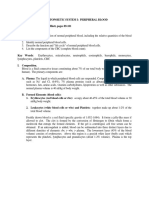B & C, Vol-11 PDF
B & C, Vol-11 PDF
Uploaded by
Kiran RmvCopyright:
Available Formats
B & C, Vol-11 PDF
B & C, Vol-11 PDF
Uploaded by
Kiran RmvOriginal Title
Copyright
Available Formats
Share this document
Did you find this document useful?
Is this content inappropriate?
Copyright:
Available Formats
B & C, Vol-11 PDF
B & C, Vol-11 PDF
Uploaded by
Kiran RmvCopyright:
Available Formats
*MUDRA*
Life Sciences For NET & SET Exams. Of UGC-CSIR
Section B and C
Volume-11 Contents 7. SYSTEM PHYSIOLOGY-ANIMAL
A. BLOOD AND CIRCULATION B. CARDIOVASCULAR SYSTEM C. RESPIRATORY SYSTEM D. NERVOUS SYSTEM F. EXCRETORY SYSTEM 1 29 49 75 97
_____________________________________________________________________________________________ 1
Section B & C Vol-11
*MUDRA*
Life Sciences For NET & SET Exams. Of UGC-CSIR
7. SYSTEM PHYSIOLOGY-ANIMAL
A. BLOOD AND CIRCULATION
Blood Blood is a liquid connective tissue and acts as the main transporting system of the body. It consists of free cells (corpuscles) and a fluid intercellular substance (plasma), as in any other type of connective tissue, in case of blood the same definite spatial relationship does not exist between cells and intercellular substance. circulating plasma as a vehicle for transportation Blood in higher animals is circulated through definite channels constituting blood vessels, arteries and veins. In lower animals, it flows through blood spaces constituting the system of haemocoels. In general, the blood components are classified as 1) Liquid component and 2) Corpuscle component 1. LIQUID COMPONENT It includes histologically homogeneous and slightly alkaline fluid, the plasma. Chemically it is composed of proteins like globulins, albumins etc along with inorganic salts, chiefly the chloride, bicarbon it and phosphate of sodium dispersed in the water. Calcium present in a remarkably constant quantity, 1 mg per 10 cc blood 1 lie plasma constitutes 55 % of the total quantity of blood, rest of the 45 % being the formed elements, i.e. corpuscles. The percentage ratio of plasma to corpuscles is subject to fluctuations depending on physiological and pathological conditions, for example in microcytic anemia there is a marked reduction in size and number of erythrocytes Similarly, in viral infections the count of leucocytes is pretty high Plasma being the fundamental substance transporting all materials, is a mixture of various useful as well as waste substances. The origin of the plasma is not entirely clear However, it differs from the tissue
_____________________________________________________________________________________________ 2
The
fluidity of plasma allows a free movement of the corpuscles, whereas the latter use
Section B & C Vol-11
*MUDRA*
Life Sciences For NET & SET Exams. Of UGC-CSIR
fluids by the greater uniformity of its components The plasma proteins form permanent components of the plasma rather than being utilized for nutritive purpose by other tissues bathed by it Experimentally, plasma proteins can be lowered down; however, normally their steady state level is maintained. Composition of the plasma 1. Water 91 to 92% 2. Solids (a) Inorganic constituents: 0.9 % sodium, potassium, calcium, magnesium, phosphorus etc (b) Organic constituents: (i) Proteins: 7.5 % serum albumin and globulin, fibrinogen, prothrombin etc. (ii) Non-protein nitrogenous substances (NPN): Urea, uric acid, xanthine, hypoxanthene, creatine, creatinine, ammonia, amino acids etc. (iii) Fats: Neutral fats, phospholipids, cholesterol and cholesterides etc. (iv) Carbohydrates Glucose, fructose, galactose etc. (v) Other substances Hormones, antibodies and various enzymes Apart from this the plasma contains a small amount of bilirubin, carotine and xanthophyllin which impart the characteristic yellow color to the plasma 2. CORPUSCLE COMPONENT It includes various formed elements called as blood corpuscles. They remain floating in the plasma. Three types of corpuscles have been described in this component viz. (i) Red blood corpuscles (Erythrocytes), (ii) White blood corpuscles (Leucocytes): and (iii) Platelets or thrombocytes. (i) Erythrocytes (Red blood corpuscles) The erythrocytes are highly differentiated and specialized cells for the transport of respiratory gases, oxygen and carbon dioxide. In all the classes of vertebrate except _____________________________________________________________________________________________ 3 Section B & C Vol-11
*MUDRA*
Life Sciences For NET & SET Exams. Of UGC-CSIR
mammals, they are nucleated and contain haemoglobin, a respiratory pigment that gives oxygen transporting characteristic to the blood Whenever blood is exposed to a physiological pressure of oxygen, haemoglobin forms loose and reversible combination with the oxygen and gets transformed into oxyhaemoglobin. Thus, rate of oxygen uptake is highly conditioned by the partial pressure of oxygen at the site of its exchange
Erythrocyte AGRANULOCYTES Lymphocyte GRANULOCYTE Neutrophil Monocyte Eosinophil Platelets Basophil
Fig.1: Different types of blood cells
Structurally, RBC in general is a circular biconcave disc and when seen from edges appears to be a dumbbell shaped structure with about 7.7 diameter and 1.9 greatest thickness in dried smears They are about 86 diameter in the living state. Large erythrocytes are commonly found in greatest thickness in dried smears. They state Large erythrocytes are commonly found in some types of anemia like Pernicious anemia, and are known as macrocytes or megalocytes On the other hand, microcytes are the small forms also found in some anemia like iron deficiency anemia When a RBC is kept in hypotonic solution, it swells as a result of endosmosis) Further endosmosis brings about haemolysisa process in which haemoglobin diffuses out of the cell Such haemolysed erythrocytes are called as erythrocytic ghosts and are widely used in the study of permeability characteristics of the plasma membrane (Such studies have revealed that 0.85% sodium chloride solution is isotonic to the erythrocytes).
_____________________________________________________________________________________________ 4
Section B & C Vol-11
You might also like
- Origami BuildingsDocument61 pagesOrigami BuildingsKhoa Hữu77% (22)
- Project On Hotel ManagementDocument40 pagesProject On Hotel Managementdiyapaliwal1467% (3)
- Module 2 Blood and Bloostain Analysis Forensic 3Document29 pagesModule 2 Blood and Bloostain Analysis Forensic 3nikke requeNo ratings yet
- Blood Overview and IntroductionDocument8 pagesBlood Overview and IntroductionKathleen Joy Costales MagtanongNo ratings yet
- Biochemistry of Diseases Dr. Jishnunil Chakraborty: Analytical Clinical Biochemistry (Sec-A2)Document28 pagesBiochemistry of Diseases Dr. Jishnunil Chakraborty: Analytical Clinical Biochemistry (Sec-A2)Pedro SilvaNo ratings yet
- Biochemistry of Diseases Dr. Jishnunil Chakraborty: Analytical Clinical Biochemistry (Sec-A2)Document21 pagesBiochemistry of Diseases Dr. Jishnunil Chakraborty: Analytical Clinical Biochemistry (Sec-A2)Pedro SilvaNo ratings yet
- Forensic Serology and DNA-1-mergedDocument205 pagesForensic Serology and DNA-1-mergedNandini SinghNo ratings yet
- Práctica RespiratorioDocument10 pagesPráctica Respiratorioandrea.valencia5411No ratings yet
- Hematology 16 Slides CombinedDocument291 pagesHematology 16 Slides CombinedHawaid AhmadNo ratings yet
- Blood FactsDocument13 pagesBlood FactsKevin MartinezNo ratings yet
- 1378968920.48619-Blood - PDF Lab: March 2019Document19 pages1378968920.48619-Blood - PDF Lab: March 2019don aNo ratings yet
- Gjaku Dhe HemopoezaDocument56 pagesGjaku Dhe HemopoezaGent'No ratings yet
- Chapter 12. BloodDocument23 pagesChapter 12. BloodJeriz Marie GamboaNo ratings yet
- Blood: Figure 1: Shows Separated Blood Layers by CentrifugeDocument7 pagesBlood: Figure 1: Shows Separated Blood Layers by Centrifugeحسين مهديNo ratings yet
- BloodDocument18 pagesBloodMichael HabibNo ratings yet
- Blood Composition (3) .Docx1.Docx 2Document15 pagesBlood Composition (3) .Docx1.Docx 2Mulook AlsheikNo ratings yet
- Blood and Clotting FactorsDocument34 pagesBlood and Clotting FactorsAnand KasiNo ratings yet
- Blood FinalDocument14 pagesBlood FinalAnkit PattnayakNo ratings yet
- BloodDocument12 pagesBlooddeviNo ratings yet
- Heamatology 1Document57 pagesHeamatology 1Victoria &BeautifulPeopleNo ratings yet
- 10.dcardiovascular System 2Document16 pages10.dcardiovascular System 2DylanNo ratings yet
- Physiology of Blood and Body Fluids Mbbsii Bdsii Lecture Note 2019-2020Document39 pagesPhysiology of Blood and Body Fluids Mbbsii Bdsii Lecture Note 2019-2020MUHAMMAD AHMAD HAMMANo ratings yet
- Module 12 The Composition and Function of BloodDocument11 pagesModule 12 The Composition and Function of BloodMisha WilliamsNo ratings yet
- Anatomy of Hematology PPT EddDocument118 pagesAnatomy of Hematology PPT EddGirmay GebrehiwotNo ratings yet
- Blood PhysiologyDocument14 pagesBlood PhysiologyRimsha MustafaNo ratings yet
- Forensic Existence of Blood As A Dynamic PDFDocument5 pagesForensic Existence of Blood As A Dynamic PDFiqrarNo ratings yet
- Haematology: Presented By: Prof - Mirza Anwar BaigDocument154 pagesHaematology: Presented By: Prof - Mirza Anwar BaigHabib UllahNo ratings yet
- Blood Physiology (Phs 211) Blood: Definition and IntroductionDocument7 pagesBlood Physiology (Phs 211) Blood: Definition and IntroductionFavour OnyeaboNo ratings yet
- BloodDocument38 pagesBloodchukwukerechimezirimNo ratings yet
- Tugas Anatomi IntegumenDocument26 pagesTugas Anatomi IntegumenLailia nur rachmaNo ratings yet
- Peripheral Blood 1Document7 pagesPeripheral Blood 1اليهري اليافعيNo ratings yet
- A. Functions of Blood SystemDocument7 pagesA. Functions of Blood SystemPrant ChikyNo ratings yet
- Blood Notes PDFDocument13 pagesBlood Notes PDFsyedurrahman855No ratings yet
- Blood and LymphDocument13 pagesBlood and LymphchiurungetinasheNo ratings yet
- Blood and Body FluidsDocument24 pagesBlood and Body FluidsQasim NaeemNo ratings yet
- Chapter 17 Anatomy and Physiology NotesDocument10 pagesChapter 17 Anatomy and Physiology NotesZachary WatsonNo ratings yet
- Blood: TransportationDocument29 pagesBlood: TransportationShobhit GajbhiyeNo ratings yet
- Christine Angel Mae Balsomo - BLOOD WORKSHEETDocument4 pagesChristine Angel Mae Balsomo - BLOOD WORKSHEETChristine angel mae BalsomoNo ratings yet
- BCH 408Document13 pagesBCH 408ezekielolami01No ratings yet
- Lab 25 BloodDocument23 pagesLab 25 Bloodrhycelayon304No ratings yet
- Aspek Biokimiawi HematologiDocument72 pagesAspek Biokimiawi HematologiExcelsis Deo SombolinggiNo ratings yet
- Physiology of BloodDocument59 pagesPhysiology of BloodFarah AljayyousiNo ratings yet
- GRP 5 Hematopoietic System ImlanDocument49 pagesGRP 5 Hematopoietic System ImlanSharie Grace ImlanNo ratings yet
- Blood and Immune SystemDocument34 pagesBlood and Immune SystemIrene VuremyNo ratings yet
- Blood Physiology in Physio-1 On BmeDocument47 pagesBlood Physiology in Physio-1 On BmeGUIDE ON BIO-MEDICAL ENGINEERING UNDERGRADUATE PROGRAM:No ratings yet
- Unit 2-Blood Guided NotesDocument5 pagesUnit 2-Blood Guided NotesJeanette IrambonaNo ratings yet
- Hematopoiesis and ErythropoiesisDocument15 pagesHematopoiesis and Erythropoiesistasnimayman1463No ratings yet
- Anatomy Circultion1Document17 pagesAnatomy Circultion1Keinneth JacobNo ratings yet
- The Circulatory System 2. 1 Composition and Function of BloodDocument29 pagesThe Circulatory System 2. 1 Composition and Function of BlooddevNo ratings yet
- Lec-1 Hematopoiesis and RBCsDocument38 pagesLec-1 Hematopoiesis and RBCsMuna MNo ratings yet
- Cardio Vascular SystemDocument18 pagesCardio Vascular SystemjeniferNo ratings yet
- 2 CVS BloodDocument26 pages2 CVS BloodSepo CaciousNo ratings yet
- Written Report Copy BloodDocument29 pagesWritten Report Copy BloodNathalieCaracaNo ratings yet
- Chapter 20 - The Cardiovascular System - Blood Functions of BloodDocument7 pagesChapter 20 - The Cardiovascular System - Blood Functions of Bloodlovelyc95No ratings yet
- BloodDocument70 pagesBloodbookaccountNo ratings yet
- Blood and He Ma To PoiesisDocument19 pagesBlood and He Ma To PoiesisDrishtantRaghavNo ratings yet
- Hematology Review NotesDocument28 pagesHematology Review NotesMeLaiyee89% (9)
- BLOODDocument2 pagesBLOODcharuislostNo ratings yet
- Blood CirculatoryDocument5 pagesBlood CirculatoryRekesh SaeedNo ratings yet
- BLOODDocument10 pagesBLOODChrisjohn Aster OsioNo ratings yet
- VSP-UG-1 (Blood)Document70 pagesVSP-UG-1 (Blood)Samartha SamdarshiNo ratings yet
- Research Paper FormatDocument2 pagesResearch Paper FormatKiran RmvNo ratings yet
- Spectral Analysis of The Vedic Mantra OmkaraDocument5 pagesSpectral Analysis of The Vedic Mantra OmkaraKiran RmvNo ratings yet
- B & C, Vol-12 PDFDocument4 pagesB & C, Vol-12 PDFKiran RmvNo ratings yet
- Csir Net Answer KeyDocument10 pagesCsir Net Answer KeyKiran RmvNo ratings yet
- Phytochemical Survey of Orchids in South IndiaDocument8 pagesPhytochemical Survey of Orchids in South IndiaKiran RmvNo ratings yet
- Else-Antifeedant, Insecticidal and Growth Inhibitory Activities of SelectedDocument5 pagesElse-Antifeedant, Insecticidal and Growth Inhibitory Activities of SelectedKiran RmvNo ratings yet
- Liquid Crystal Bow-Tie Microstrip Antenna For WireDocument5 pagesLiquid Crystal Bow-Tie Microstrip Antenna For WireFelipe RabeloNo ratings yet
- Surpac Geology Advanced Analysis&Geostatistics 3 Days AUDocument5 pagesSurpac Geology Advanced Analysis&Geostatistics 3 Days AUJessper Evan AmpagueyNo ratings yet
- Mechanical Seals Pumping Plans - ENDocument1 pageMechanical Seals Pumping Plans - ENDomingo DíazNo ratings yet
- Recognizing Bowel Obstruction and IleusDocument35 pagesRecognizing Bowel Obstruction and IleusmustikaNo ratings yet
- FCC GuideDocument2 pagesFCC GuideEliecer AyalaNo ratings yet
- Investigation of Ionic Conduction in PEO-PVDF Base-3Document1 pageInvestigation of Ionic Conduction in PEO-PVDF Base-3TaniaNo ratings yet
- Audio JammerDocument2 pagesAudio JammerKazi Mazzad Ahmed TitasNo ratings yet
- Autoclave Reactor PatentDocument9 pagesAutoclave Reactor PatentPrabandari 632No ratings yet
- DA32UQ User Manual: FeaturesDocument12 pagesDA32UQ User Manual: FeaturesMBAHWIERNo ratings yet
- RR - Amyl AcetateDocument20 pagesRR - Amyl Acetatezulfy353No ratings yet
- Auto Control Loops in Thermal Power Plant: Sith - Ananda KumarDocument37 pagesAuto Control Loops in Thermal Power Plant: Sith - Ananda KumarVignesh RajanNo ratings yet
- SynchronousDocument2 pagesSynchronousSubhuNo ratings yet
- Graphics Chap 14 BakerDocument44 pagesGraphics Chap 14 BakerBHAVYA MALIK 204052No ratings yet
- Schropp Et Al (2005) Immediate Vs Delayed IJOMIDocument9 pagesSchropp Et Al (2005) Immediate Vs Delayed IJOMIAlla MushkeyNo ratings yet
- Grade 11-1st Quarter-Module 2-Evaluating-FunctionsDocument6 pagesGrade 11-1st Quarter-Module 2-Evaluating-FunctionsEdal SantosNo ratings yet
- 0 Proportional Speed Regulator With IntegratorDocument2 pages0 Proportional Speed Regulator With IntegratortuNo ratings yet
- Pre-Calculus: Quarter 1 - Module 5: Determine The Standard Form of Equation of A ParabolaDocument32 pagesPre-Calculus: Quarter 1 - Module 5: Determine The Standard Form of Equation of A ParabolaMark Allen Labasan100% (2)
- Detection and Enumeration of Heat-Resistant MoldsDocument7 pagesDetection and Enumeration of Heat-Resistant Moldsabekhti2008No ratings yet
- CMRL P2C401 Final Report 1-319-338Document20 pagesCMRL P2C401 Final Report 1-319-338Kishore KumarNo ratings yet
- Science Oct 2018 Paper 1 MSDocument12 pagesScience Oct 2018 Paper 1 MSJeffrey Piggott100% (4)
- fr = 0.7λ√𝑓′𝑐 fr = 0.62λ√𝑓′𝑐 fr = 0.62λ√𝑓′𝑐Document2 pagesfr = 0.7λ√𝑓′𝑐 fr = 0.62λ√𝑓′𝑐 fr = 0.62λ√𝑓′𝑐JamesNo ratings yet
- Facts at Your Fingertips: Insulating Heat-Transfer-Fluid PipingDocument1 pageFacts at Your Fingertips: Insulating Heat-Transfer-Fluid PipingEhrlish UrribarriNo ratings yet
- GB Catalog Threading 2015 Inlay LRDocument113 pagesGB Catalog Threading 2015 Inlay LRMohammad KurdiaNo ratings yet
- Conductivity, Temperature, Depth: From Wikipedia, The Free EncyclopediaDocument3 pagesConductivity, Temperature, Depth: From Wikipedia, The Free EncyclopediasanilNo ratings yet
- Analysis of GNSS Baseline Solutions in GhanaDocument11 pagesAnalysis of GNSS Baseline Solutions in Ghanawn1529.20000No ratings yet
- MODEL: OT150-12 NO.:: Plane Chart: TerminalDocument2 pagesMODEL: OT150-12 NO.:: Plane Chart: TerminalOrlando GómezNo ratings yet
- V Po-To 3Document60 pagesV Po-To 3Pierre799es100% (2)
- V1600D Series Software Release NotesDocument35 pagesV1600D Series Software Release NotesRomario Cabral0% (1)


